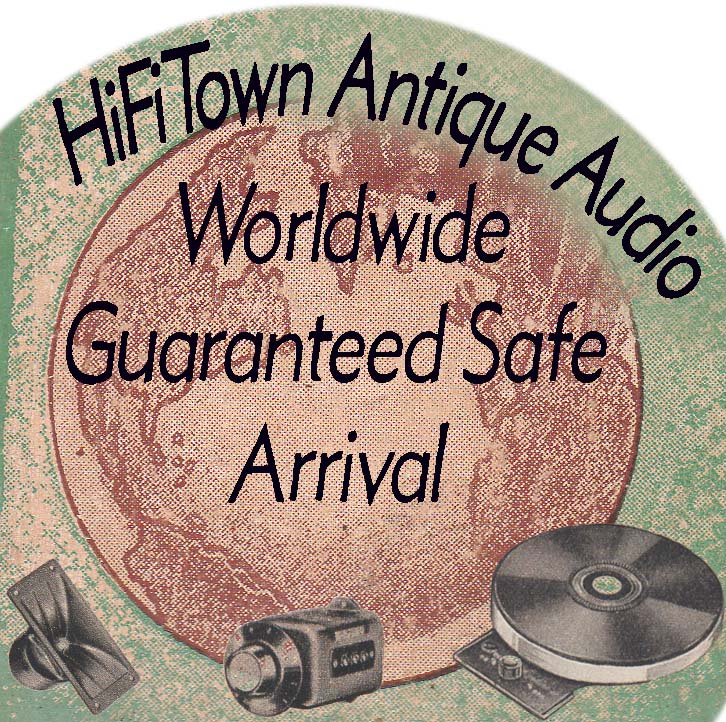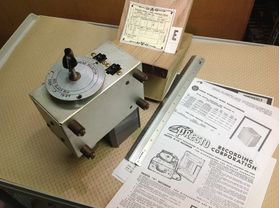A pair of 1950's ultra-tweeters -- a known and irresistible tweaky add-on to otherwise happy owners of classic bookshelf systems. These add form and function to any nice mid-century bookshelf -- most notably AR's.
By the time Stereo became must-have technology -- demanded by spoiled, cutting edge audiophiles -- market interest grew in shrinking the then mammoth bass reflex and horn loaded systems -- these 1940s systems sounded nice but were huge. Amps were getting more powerful by the early 1950's which allowed experimentation with sealed cabinets, high compliance woofers and domed mids -- a radically new idea at the time.
For the self aware and educated, scientifically minded 1950's post war consumer, no speaker choice was ever more sensible or more essential thant the new Acoustic Research speaker line. The AR-1, shown at the Brussels World's Fair in 1957 -- was the foot in the door for the realization of a reasonably sized speaker capable of full range + effective bass. It improperly used the phenonominal 755A -- in a an unfairly small sealed box -- punished into the role of both Mid and Tweeter -- it didn't work as well as it could have.
Collectors and audiophiles alike should seek the better versions -- maybe the early AR2, and especially the great AR3 and AR3A. AR's 3 way finally realized that inital promise. Sealing the deal- a truly good sounding bookshelf with significant and fairly realistc LF. Largely thanks to AR's in-house, self built terrific world class woofer, mid and tweeter -- heavy magnets and quality diaphragms. These will go down in history as some of the best post 1940s compontetized drivers -- ever. The early ALINICO and Ferrite versions made between the 50s-60s are in the top tier of USA made reproducers.
The AR bookshelf was an ambitous product, and as with so many, many great sounding speakers -- benefits and enchanced clarity can come from adding more UHF. More so the AR2 but the AR3 benefit innensely from set top additions. The AR line was tough to improve on. They were flat, had lots of accentuated bass within reason -- reasonably efficent ( near field, I play nice AR-3A's at only 1-2 watts!). Like any speaker system -- at medium low and low volumes (thanks to the F-M curve) they don't always have enough prescence or highs. Room for a suitably modern, 1950's style accessory became evident. The thick grilles of the early AR's, along with room acoustics and other problems like dark amps, swiftly starved all of the conservative HF these speakers delivered.
By the late 1950s, for the AR-1 the Janzen already designed such an accessory for bookshelf(s) -- already producing their own line of the interesting electrostatc speakers -- Janzen was quick to market with a killer space age design. Ultra modern multi-faceted electrostatic tweeter panels -- self contained, attractive, the heirloom quality of real wood -- these quickly became a hit with HF starved owners of all the AR bookshelfs ... seeking even more realism in a small space -- Janzen's delevered this -- but in the long run they were not terribly reliable. The Janzen units are really cool. They are larger, and also handbuilt -- frequently needing total restoration -- and the panels don't last without rebuilding. Collectors and needful AR owners have driven these rare tweeter sets to stellar values. Janzens are finicky and fragile -- best for advanced audiophiles with patience ready to tackle restoration.
Rather than trying to find more expensive Janzen's .. consider these ... you don't see these older electrostat-3's much .. Realistic's 1950s era version ... very well respected for this same purpose, they're smaller, really darn effective and extremely well built (better parts inside than Janzen). In a departure from the hastily made Janzens, we see Realsitc's ad was proud to show off the insides -- they feature high quality HV supplies with oil caps and wirewound resistors ... no corners cut -- really high quality and likely why they still work! Study all of the Exhibit photos, the original literature, and watch the video -- below for more details. They are great to add to most any 1950s era bookshelf. Keep in mind, both these and the Janzens are strict tweeters. These Realistics have sharp roll-off HF filters, keeping out anything under 5K. This keeps your living room looking clean and modern.
Again, keep in mind electrostatic units like these make near UHF output that isn't "loud" or nasty -- it's not going to grate on you or shear your ears away --- UHF twinkle or "breath" from these is very subtle and really adds a new sense of spirit ... a new type of "alertness" the speaker didn't have before -- and that's all. It's not going to give radical highs that would blow your top off -- or drastically alter the sound of your nice speakers. They are a cool 1950's tweak -- a nice idea to make already natural sounding bookshelf speakers sound more natural. These are not as large as the biggest Janzens of the mid 1950s...that went lower in their big system ... They're in my opinion best as an addition to AR3's or any speaker with a tweeter that might benefit from a little more twinkle. Easy to add to any system, as they've got the high-pass filter built right in. You really can't blow these like other nice convential tweets (famously fragile to use are the Altec 3000A, Stephens Tru-Sonic, T35, T350, or the RP302 by Jensen). Unlike some, they're are not as aggressive, and they're much more rugged in application.
Cosmetic condition: Both units are pretty well matched for their age, with only a few slight cosmetic / production variations. Both have a very aged, still shiny, nearly irredescently finished mahagony laquer that really sets them off! The laquer on unit #1 is somewhat darker, and it's got the original RS badge. They have many nicks and flaws -- cosmetics are fair, as the nearly 60 years have left them with many nicks, chips and a couple of really small veneer flaws; especially on the bottom (see Exhibit O). With they 54 years of original patina, they still actually present beautifully. (see Exhibit F) The back panels feature connections for 8 and 16 ohm and match nicely. The owner applied a felt marker on one, and did at least nicely hand draw in pencil his assesment of the operational circuit -- on the back panel, see Exhibit B.
Function: These tweeters are old, original and appear to be working. I tested each tweeter for over 25mins each. Both were impedance swept, the resulting curves shows them to be well matched, true UHF (not just HF) output tweeters. The DCR for unit 1 and 2 were well matched on both the 8ohm and 16ohm taps (see Exhibit G) for full reports. I checked them with meters, and carefully listened -- both seem to be working OK. Each unit's 3 panels produce good output and I got lively respose on a DB meter from each panel during testing with simple music. Usually, Electrostatic panels of this age need service or at least cleaning, so expect eventually to do so (if you're going to use regularly) -- keep in mind though these may, at some point need service or maintenance too -- as with any high voltage, complex electrostaic product with age -- for now, as you can see and hear in video below are working pretty well and certainly matched with each other.
These are directly from the original owner's estate -- he used them and considered them essential additions to his AR3a's. They are from a non smoking home, very important plus, as electrostatic panels attract dirt and dust over time.
They are uncommon to find nicely matched, and rarely do sellers bother to test as I have. They were a fairly pricey high-end purchase back in the late 1950s, carrying a price of $75 per pair -- the equivalent of $573 today. Not too many were sold, and few of these survive today. They're cool examples of early electrostatic technology and are still really useful today.
Copyright 2013 HiFiTown.com
The documents and test reports for each tweeter are included.
The AR-3a I used to test with is not included.
See our 100% feedback, to be assured SAFE PACKING & DELIVERY. This is likely the only nice set you'll see for awhile. They're the perfect gift for owners / collectors of early AR -- and you'll find them an extremely useful curio. They're attractive mid-century collectiables you can enhoy! They make a wise investment for enthusuists of 1950s HiFi. Buy now to avoid a bidder's war .. take your time, study the reports and photos below ... and jump on them soon -- as these are not common any longer -- so they'll sell quickly. Will be DOUBLE BOXED for SAFE OVERSEAS shipment in strong 275lb triwall cartons. Please read our 100%, 5 star feedback. All happy customers.
Please study photos below. SAFE PURCHASE, 100% - *** Domestic or OVERSEAS OK. FAST SHIPPING, WILL DISPATCH IMMEDIATELY after PAYMENT -- OVERSEAS OK, FULL TRACKING number via email after shipment.













